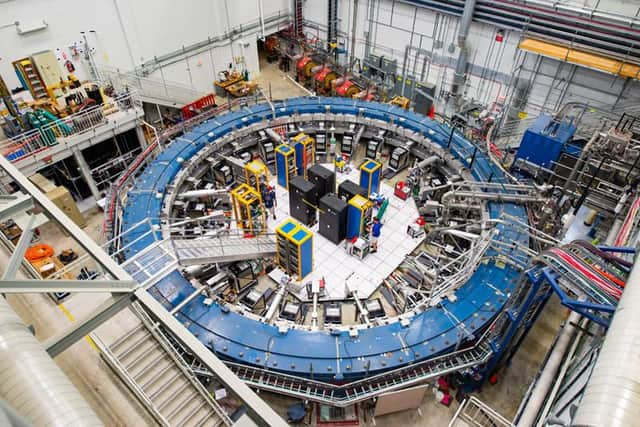What is a muon? Fundamental particle and g-2 experiment explained – and what the results could mean for physics


Scientists are close to making a finding which could alter the way physicists think about the fundamentals of life in the universe.
A team of researchers at US Department of Energy’s Fermi National Accelerator Laboratory, about 35 miles west of Chicago, have released the long-awaited first results of their Muon g-2 experiment.
Advertisement
Hide AdAdvertisement
Hide AdTheir findings suggest that muons do not behave in line with how the Standard Model – the currently understood workings of the universe, and scientists’ best particle physics theory – predicts they should.
If the result is verified, it could force a rewrite of many of the rules of physics, suggesting that muons are interacting with as yet undiscovered particles or forces.
Here is everything you need to know about it.
What is a muon?
A muon is a fundamental particle, one of the building blocks of mass in the universe.
A fundamental particle is one that cannot be broken down into anything smaller than itself, it is a particle that is not made of other particles.
Advertisement
Hide AdAdvertisement
Hide AdAtoms for instance are made up of three main parts: protons, neutrons and electrons. Muons are not ‘made up’ of anything, they are themselves.
They act as a window into the subatomic world, and could be interacting with yet undiscovered particles or forces.
A muon has an average life time of 2.2 microseconds, or 0.0000022 seconds.
How did the experiment work?
Muons occur naturally when cosmic rays strike Earth’s atmosphere, and act as if they have a tiny internal magnet; in a magnetic field, the muon’s internal “magnet” vibrates.
Advertisement
Hide AdAdvertisement
Hide AdThe strength of the particle’s internal “magnet” determines the rate at which a muon vibrates, a process described by a number of physicists as the “g-factor”.
Using the Standard Model, this vibration or “g-factor” can be calculated with ultra-high precision.
But as scientists passed muons through the Muon g-2 magnet, bombarding them with a quantum “foam” of subatomic particles popping in and out of existence, they didn’t seem to interact quite as they should have.
These unpredictable changes in the g-factor suggest that additional forces or particles yet undiscovered could be at play.
Advertisement
Hide AdAdvertisement
Hide Ad“This is strong evidence that the muon is sensitive to something that is not in our best theory,” said Renee Fatemi, a physicist at the University of Kentucky and the simulations manager for the experiment.
Scientists measured the interactions of the muons with “everything else in the universe”, but when calculating the g-factor “using all of the known forces and particles in the Standard Model”, they “didn’t get the same answer.”
What do the findings mean?
The result of the experiment has been made with “unprecedented precision”, but has yet to reach the level of 5 sigma – or a one in 3.5 million chance of the observation being a coincidence – at which scientists can officially claim a discovery.
However, with the results sitting at 4.2 sigma, experts say it still represents “compelling evidence of new physics”.
Advertisement
Hide AdAdvertisement
Hide AdThe UK's Science and Technology Facilities Council (STFC) told the BBC the result "provides strong evidence for the existence of an undiscovered subatomic particle or new force".
Professor Mark Lancaster, the UK lead for the experiment, told BBC News that the results “potentially point to a future with new laws of physics, new particles and a new force which we have not seen to date."